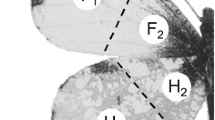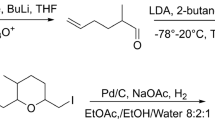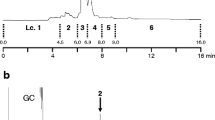Abstract
Male neotropical orchid bees (Euglossini) collect volatiles from varied sources in their environment to compile complex, species-specific tibial perfumes, which are later released at mating sites. A major compound prominent in tibial extracts of Euglossa allosticta was purified, as well as isolated and its structure was elucidated by analytical methods including GC–MS, GC–FTIR, HRMS and 1H and 13C NMR. After synthesis, the compound with the proposed structure was finally identified as 6-(4-methylpent-3-en-1-yl)naphthalene-1,4-dione. At field sites in Panama and Costa Rica, the synthetic compound attracted males of E. allosticta, but no other euglossines. This strengthens the view that semivolatiles play an important role in conveying specificity to perfume signals of orchid bees.


Similar content being viewed by others
References
Brand P, Ramirez SR, Leese F, Quezada-Euan JG, Tollrian R, Eltz T (2015) Rapid evolution of chemosensory receptor genes in a pair of sibling species of orchid bees (Apidae: Euglossini). BMC Evol Biol 15:176
Chan STS, Pullar MA, Khalil IM, Allouche E, Barker D, Copp BR (2015) Bio-inspired dimerisation of prenylated quinones directed towards the synthesis of the meroterpenoid natural products, the scabellones. Tetrahedron Lett 56:1486–1488
del Corral JMM, Gordaliza M, Castro MA, Mahiques MM, San Feliciano A, García-Grávalos MD (1998) Further antineoplastic terpenylquinones and terpenylhydroquinones. Bioorg Med Chem 6:31–41
del Corral JMM, Castro MA, Gordaliza M, Martin ML, Oliveira AB, Gualberto SA, Garcia-Gravalos MD, San Feliciano A (2002) Synthesis and biological evaluation of cytotoxic 6(7)-alkyl-2-hydroxy-1,4-naphthoquinones. Arch Pharm 335:427–437
Eltz T, Roubik DW, Lunau K (2005a) Experience-dependent choices ensure species-specific fragrance accumulation in male orchid bees. Behav Ecol Sociobiol 59:149–156
Eltz T, Sager A, Lunau K (2005b) Juggling with volatiles: exposure of perfumes by displaying male orchid bees. J Comp Physiol A 191:575–581
Eltz T, Zimmermann Y, Haftmann J, Twele R, Francke W, Quezada-Euan JJG, Lunau K (2007) Enfleurage, lipid recycling and the origin of perfume collection in orchid bees. Proc R Soc B 274:2843–2848 doi. https://doi.org/10.1098/rspb.2007.0727
Eltz T, Zimmermann Y, Pfeiffer C, Ramírez Pech J, Twele R, Francke W, Quezada-Euan JJG, Lunau K (2008) An olfactory shift is associated with male perfume differentiation and species divergence in orchid bees. Curr Biol 18:1844–1848
Eltz T, Hedenström E, Bang J, Wallin EA, Andersson J (2010) (6R,10R)-6,10,14-Trimethylpentadecan-2-one, a dominant and behaviorally active component in male orchid bee fragrances. J Chem Ecol 36:1322–1326. https://doi.org/10.1007/s10886-010-9873-4
Gerlach G, Schill R (1991) Composition of orchid scents attracting euglossine bees. Bot Acta 104:379–391
Gordaliza M, del Corral JMM, Castro MA, Mahiques MM, Garcia-Gravalos MD, San Feliciano A (1996) Synthesis and bioactivity of new antineoplastic terpenylquinones. Bioorg Med Chem Lett 6:1859–1864
Mitko L, Weber MGW, Ramírez SR, Hedenström E, Wcislo WT, Eltz T (2016) Olfactory specialization for perfume collection in male orchid bees. J Exp Biol 219:1467–1475. https://doi.org/10.1242/jeb.136754
Pokorny T, Hannibal M, Quezada-Euan JJG, Hedenström E, Sjöberg J, Bång J, Eltz T (2013) Acquisition of species-specific perfume blends: Influence of habitat-dependent compound availability on odour choices of male orchid bees (Euglossa spp.). Oecologia 172:417–425
Pokorny P, Vogler I, Losch R, Schlütting P, Juarez P, Bissantz N, Ramirez SR, Eltz T (2017) Blown by the wind: the ecology of male courtship display behavior in orchid bees. Ecology 98:1140–1152
Ramírez SR, Eltz T, Fujiwara MK, Gerlach G, Goldman-Huertas B, Tsutsui ND, Pierce NE (2011) Asynchronous diversification in a specialized plant-pollinator mutualism. Science 333:1742–1746
Vogel S (1966) Parfümsammelnde Bienen als Bestäuber von Orchidaceen und Gloxinia. Österr Bot Zeit 113:302–361
Weber MG, Mitko L, Eltz T, Ramírez SR (2016) Macroevolution of perfume signalling in orchid bees. Ecol Lett 19:1314–1323
Whitten WM, Young AM, Stern DL (1993) Nonfloral sources of chemicals that attract male euglossine bees (Apidae: Euglossini). J Chem Ecol 19:3017–3027
Zimmermann Y, Ramírez SR, Eltz T (2009) Chemical niche differentiation among sympatric species of orchid bees. Ecology 90:2994–3008
Acknowledgements
TE was funded by the German Science Foundation (EL 249/6 and 11) and EH, FA and NS were funded by the County Administrative Board of Västernorrland and by the European Union Regional Development Fund.
Author information
Authors and Affiliations
Corresponding authors
Additional information
Communicated by Günther Raspotnig.
Electronic supplementary material
Below is the link to the electronic supplementary material.
Rights and permissions
About this article
Cite this article
Hedenström, E., Andersson, F., Sjöberg, N. et al. 6-(4-Methylpent-3-en-1-yl)naphthalene-1,4-dione, a behaviorally active semivolatile in tibial perfumes of orchid bees. Chemoecology 28, 131–135 (2018). https://doi.org/10.1007/s00049-018-0264-6
Received:
Accepted:
Published:
Issue Date:
DOI: https://doi.org/10.1007/s00049-018-0264-6




